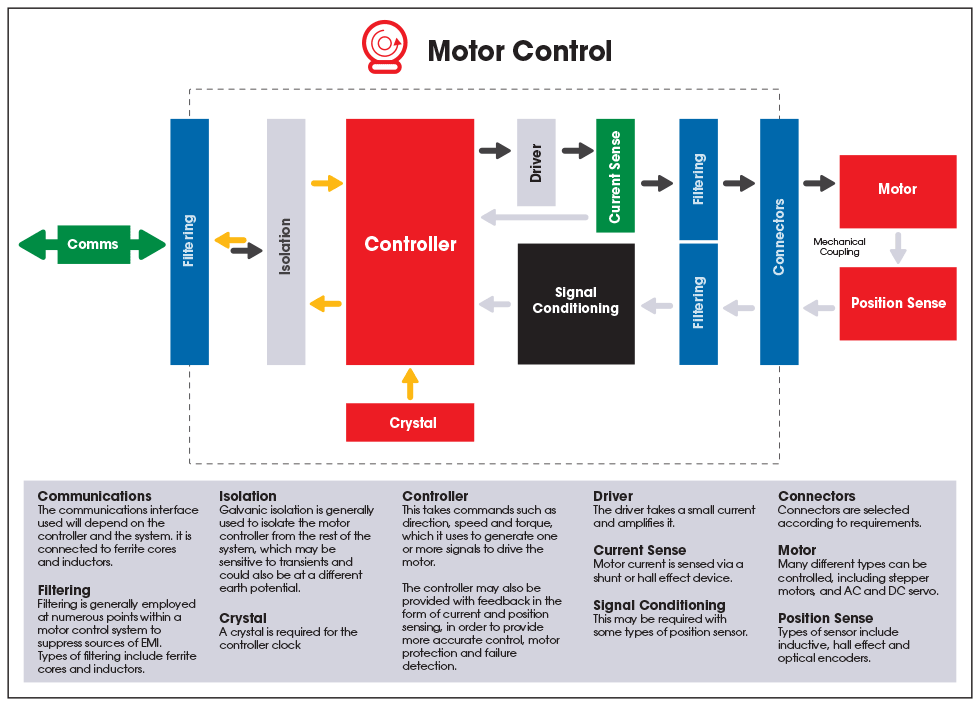Around 45% of our global energy consumption is from the operation of motors (World Energy Council: 2013 Survey Summary). They are a power-hungry but essential part of our daily lives and are found everywhere from small residential uses, such as household appliances and tools, through electric cars and trains in the transportation sector, right up to the largest industrial motors for offshore oil rigs and damns.
Since the industrial revolution we have been reducing time and labour by powering anything that we possibly could with a motor. A mass of electrically-powered devices have made our home lives easier and more convenient and our workplaces more efficient and profitable. But at what cost?
Energy-eating motors and the environment
In our modern world of diminishing fossil fuels, amidst fears for our ecology and environment, manufacturers of any goods driven by motors face challenging times ahead. With no wide-scale alternatives yet derived from renewable energy sources, the problem is exacerbated by an increase in demand coming from growing economic development in Africa, Asia and South America, coupled with our rapidly expanding global population.
Around the world, governments have been putting increasing legislative measures into place to reduce energy consumption for some years and these are only set to increase further. In addition, consumers in a retail sense are far smarter and look for low energy-consuming products routinely; the same is true for industrial customers looking to invest in more efficient equipment.
Miniaturising motors
In addition to minimising power usage, engineers are also challenged with squeezing motors, drives and their controllers into increasingly smaller dimensions. A washing machine that features a larger drum capacity offers a value-adding selling point to the customer, but it still needs to fit within standard dimensions. Reducing space for electronic components creates thermal management issues which pose further design challenges for engineers. Adding cooling mechanisms will only increase power consumption, so the motors themselves need to be engineered with improved efficiency levels so less heat is generated in the first place.
Motor Control Architecture
Motor Control Systems
The above diagram shows the building blocks of a typical motor control system depending on the type of motor, application, level of control and, if any, monitoring that is required.
Controller - Typically a microcontroller or DSP. This takes commands such as direction, speed and torque, which it uses to generate one or more signals to drive the motor, usually PWM. The controller may also be provided with feedback in the form of current and position sensing, in order to provide more accurate control, motor protection and failure detection.
Driver - More often than not a driver is required to amplify the signals generated by the controller in order to deliver sufficient power to the motor.
Sensors - A shunt or hall effect device may be used to measure the actual current supplied, thereby providing feedback. Actual motor position feedback may also be provided via an inductive or hall effect sensor, or encoder. This feedback can then be used to implement more sophisticated “closed loop” control providing actual information around the motor to better control the output.
Filtering - Filtering is generally employed at numerous points within a motor control system to suppress sources of Electromagnetic Interference (EMI). Types of filtering include ferrite cores and inductors.
Isolation - Galvanic isolation is generally used to isolate the motor controller from the rest of the system, which may be sensitive to transients and could also be at a different earth potential.
Open and Closed Loop Motors
To explain this in its most basic and simple context, an open loop system does not incorporate any feedback. The speed of the motor is controlled to a set point which can vary under different load conditions.
A closed loop system incorporates feedback by returning information to the input stage to adjust itself. So when speed is controlled to a set point and the load changes, the controller will adjust the speed back to the set point; a good example of this is a positional motor on a telescope which will constantly readjust itself to track the required co-ordinates.
closed Loop diagram
Brushless DC (BLDC) Motors
By Elvir Kahrimanovic, Senior Application System Engineer at Infineon.
From cordless power tools to industrial automation and from electric bikes to remote-controlled ‘drones’, an increasing number of motion control applications are now being built around the brushless DC (BLDC) motor. While BLDC solutions require more complex drive electronics than brushed alternatives, these motors offer a number of operational advantages that include higher efficiency and higher power density. This allows smaller, lighter and less expensive motors to be deployed. At the same time, there is less mechanical wear-and-tear, which leads to higher reliability, longer lifetimes and eliminates need for ongoing maintenance. BLDC motors also operate with lower audible and electrical noise than their brushed counterparts.
Sometimes referred to as an electronically commutated motor (ECM), a typical BLDC motor has a three-phase stator which keeps turning the rotor via an electronic control scheme that incorporates a three-phase inverter circuit. This circuit continually switches currents in the stator windings in synch with the rotor position which can be ascertained via sensors or through calculations based on the back electromotive force (EMF) at any particular moment. The flux generated in the stator interacts with the rotor flux, which defines the torque and the speed of the motor.
When designing a BLDC application, engineers can choose between using discrete components or integrated semiconductors that bring together a number of important drive and control functionalities into a single device.
Get in-depth information in Infineon’s white paper: Power Loss and Optimised MOSFET Selection in BLDC Motor Inverter Designs available via DesignSpark.
Keep reading to find out about other motor types – Brushed DC and AC motors.
